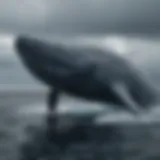Understanding Polar Bear Predators: Ecosystem Insights
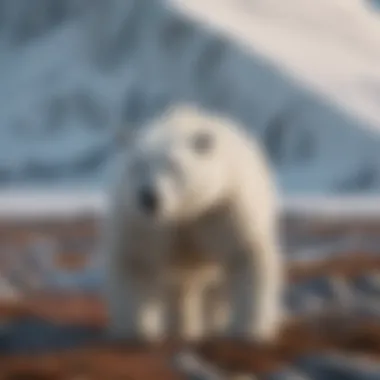

Nature Topic Overview
Polar bears, often known as the kings of the Arctic, face many challenges in their environment. They are not only magnificent creatures but also crucial indicators of ecological health. This section begins an exploration into who preys upon them, their primary threats, and how climate change modifies their habitat. Understanding these dynamics is essential for appreciating polar bears' role in the ecosystem.
Key Points to Discuss
- Predators of Polar Bears: The different threats these bears face.
- Impact of Environmental Changes: How climate change affects their survival.
- Ecosystem Balance: The relationship between polar bears, their prey, and their habitat.
- Conservation Needs: Why we should care about their protection.
Fun Facts and Trivia
- Did you know polar bears are classified as marine mammals? They spend most of their life on the sea ice of the Arctic Ocean.
- They can swim for days at a time, covering over 30 miles without rest.
- A polar bear’s fur is actually transparent and reflects light, making it appear white or cream.
Visuals might include images of polar bears in their natural habitat, and interactive elements could involve quizzes about these fun facts.
Wildlife Explorations
Polar bears share their habitat with various species, such as seals, musk oxen, and Arctic foxes. Each of these animals plays a crucial role in the Arctic food chain.
Related Species
- Walrus: These large marine mammals also inhabit the Arctic, sharing similar feeding grounds.
- Seals: They are a primary food source for polar bears, especially ringed seals.
Children might enjoy completing puzzles about these animals to reinforce their learning.
Environmental Awareness
The conservation of polar bears is critical not just for their species but for the entire Arctic ecosystem. As sea ice diminishes due to climate change, polar bears struggle to find food and reproduce. Every individual can play a role in conservation efforts.
Tips for Children
- Reduce, Reuse, Recycle: Simple actions to minimize waste.
- Educate Peers: Share what you learn about polar bears with friends.
DIY Nature Activities
Engaging with nature can be both fun and educational. Here are some suggestions for children:
- Create a Polar Bear Habitat Model: Use recycled materials to illustrate what a polar bear’s habitat looks like.
- Nature Walk: Go on a walk and observe local wildlife, drawing parallels to polar bears’ needs.
These activities help children apply their knowledge and encourage them to become stewards of the environment.
Prologue to Polar Bears
Polar bears are remarkable creatures, integral to the Arctic ecosystem. Understanding their characteristics and environment is crucial for several reasons. First, it helps us comprehend their role as apex predators and how they interact with other species in their habitat. Second, it sheds light on the challenges they face, especially against the backdrop of climate change and human activity. This section aims to provide a clear overview of polar bears, laying the foundation for examining the predator dynamics that define their existence.
Basic Characteristics
Polar bears, or Ursus maritimus, are the largest land carnivores in the world. Adult males can weigh between 900 to 1,600 pounds, while females are typically smaller, weighing about 500 to 800 pounds. They possess thick fur that appears white, offering excellent camouflage against the snowy Arctic landscape. Beneath their fur, a layer of fat, sometimes 4 to 5 inches thick, keeps them warm in frigid temperatures. Their primary diet consists of seals, which they hunt with remarkable skill.
Here are some important features of polar bears:
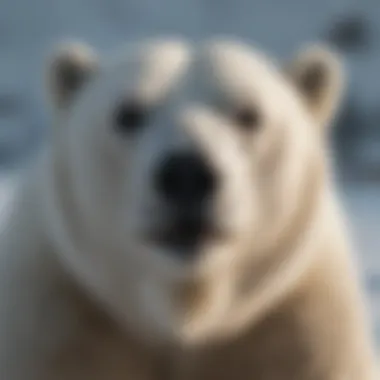

- Blubber and Fur: These adaptations provide insulation against the cold.
- Strong Limbs: They are powerful swimmers and can cover miles in the water.
- Keen Sense of Smell: They can detect seals beneath thick ice from over a mile away.
With these characteristics, polar bears are built to survive in one of the most extreme environments on Earth.
Habitat and Distribution
Polar bears primarily inhabit the circumpolar Arctic regions, including parts of Canada, Alaska, Greenland, Norway, and Russia. Their habitat is closely linked to sea ice, which they use as a platform for hunting seals. As the sea ice diminishes due to global warming, polar bears find it increasingly difficult to hunt and breed.
Key aspects of polar bear habitats include:
- Seasonal Ice: They rely on seasonal ice formation for hunting during specific months of the year.
- Land: While they prefer ice, they can also be found on land, especially during the summer months when ice melts.
- Migration Patterns: Many polar bears migrate from one area to another in search of food and denning sites.
Understanding where polar bears live helps in assessing their vulnerability and the potential for conservation efforts.
The Role of Predators in Nature
Predators play a crucial role in maintaining the balance of ecosystems. They regulate the populations of their prey, which, in turn, influences the entire food web. This section aims to uncover the various aspects of predator dynamics, particularly as they relate to polar bears and their environment. Understanding the roles and relationships within nature is vital for appreciating how species, including polar bears, survive and thrive amidst challenges.
Definition of Predators
A predator is an animal that hunts and eats other animals. This hunting behavior is essential for ecological balance. Predators can be large or small and can vary greatly in their methods of hunting. For example, polar bears actively pursue seals and other marine mammals as their main source of food. Their hunting tactics are adapted to the Arctic environment, where they rely on sea ice to catch their prey. The presence of predators often leads to a healthier and more sustainable ecosystem.
Food Chain Dynamics
Food chains illustrate the flow of energy and nutrients through an ecosystem. In this chain, predators occupy a significant position, helping to control prey populations and supporting the health of the environment. Here are some important points to consider:
- Energy Transfer: Predators play a direct role in energy transfer. As they consume prey, they obtain energy that is essential for their survival.
- Population Control: By preying on weaker individuals, predators help curb overpopulation of certain species. This ensures that resources are not depleted, allowing diverse species to coexist.
- Ecosystem Health: A diverse predator population contributes to a balanced ecosystem. Each predator has a specific role that impacts the survival of various prey species. For instance, if polar bears are removed from the Arctic, seal populations may rise dramatically, leading to negative effects on fish species and even on the health of the marine ecosystem.
"Predators are a critical component of ecosystem function. They help maintain the balance necessary for biodiversity to flourish."
Understanding the dynamics of these food chains is essential for conservation efforts, especially as polar bears face various environmental challenges. Their role as top predators in the Arctic is vital, and changes to their survival directly affect the ecological fabric of their habitat.
Identifying Polar Bear Predators
Understanding the predators that interact with polar bears is crucial for several reasons. It helps in identifying the various threats these majestic animals face. Knowing their natural predators gives insight into the dynamics of Arctic ecosystems. Furthermore, understanding how humans affect these relationships is vital in conservation efforts. This section explores the natural predators of polar bears and the implications of human activity on predator relationships.
Natural Predators of Polar Bears
Polar bears are at the top of the food chain, but they do face threats from a few natural predators. While adult polar bears do not have many enemies, cubs are particularly vulnerable.
- Other Adult Polar Bears: In certain circumstances, adult polar bears may attack cubs. Male polar bears, especially, may prey on young bears if they encounter them. This behavior often stems from competition for resources such as food and territory.
- Killer Whales: Recent studies suggest that killer whales are emerging as a novel threat. They tend to hunt in open water and can prey on polar bears, especially those on ice edges or beaches. The interaction between these species is still being studied as it becomes more common due to environmental changes.
- Human Encroachment: While not a predator in a traditional sense, human activity can pose serious threats through habitat destruction and other disturbances. When the natural environment is altered, the balance of predator-prey relationships can change significantly.
Human Impact on Predator Relationships
Humans play a complex role in the dynamics involving polar bears and their predators. As Arctic regions experience climate change, the habitat of polar bears is also changing.
- Climate Change: The warming temperatures are causing loss of sea ice. This leads to changes in prey availability and may push polar bears into more direct competition with other carnivores. A lack of stable ice forces polar bears to alter their hunting patterns and might make them more vulnerable.
- Pollution: Human activities contribute to pollution, which affects marine life. This reduction in prey can increase competition between different species, further straining relationships between polar bears and their traditional prey.
"Human encroachment changes the natural order and impacts the survival of polar bears by increasing competition for resources."
- Legal and Conservation Efforts: Several international agreements aim to protect polar bear populations. Understanding the predictors and their relationship with humans is critical for implementing effective conservation measures.
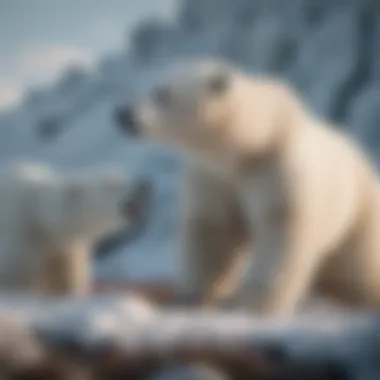

Recognizing these relationships is essential for developing effective strategies to protect polar bears and ensure their survival in the challenging Arctic environment. By understanding both natural and human-induced threats, it becomes possible to foster a balanced ecosystem where polar bears can thrive.
Environmental Challenges Facing Polar Bears
Understanding the environmental challenges facing polar bears is essential in grasping their survival and the intricacies of their habitat. The Arctic ecosystems are delicate and influenced greatly by climate conditions. Changes in temperature, ice levels, and other environmental factors can drastically affect this magnificent species. This section discusses two significant challenges: climate change and shrinking ice habitats. Addressing these issues benefits conservation efforts and highlights the importance of understanding polar bear dynamics in their ecosystem.
Climate Change and Its Effects
Climate change is perhaps the most pressing issue polar bears face today. As global temperatures rise, the Arctic region is warming at a rate faster than many other places on Earth. This warming leads to significant changes in polar bear behaviors and habitats.
- Temperature Increase: Polar bears rely on cold temperatures, especially for their hunting practices and denning. Warmer temperatures lead to earlier ice melt, forcing them to swim longer distances to find stable ice or food.
- Prey Availability: The changing climate affects seals, the primary prey of polar bears. If seals move away due to warmer waters, polar bears struggle to find food. This can lead to starvation and lower bear populations.
"Climate change threatens the entire Arctic ecosystem. Polar bears, as apex predators, are greatly affected."
Furthermore, climate change can cause unpredictable weather patterns, impacting the polar bear's hunting strategies even more. Their need for sea ice to hunt seals correlates directly with their survival and breeding success.
Shrinking Ice Habitat
The Arctic sea ice is a critical component of the polar bear's habitat. As climate change continues to reduce ice coverage in the Arctic, its implications are dire.
- Habitat Loss: With less ice, polar bears have fewer places to hunt. They rely on solid ice platforms to stalk seals. If the ice is thin or absent, it creates challenges for hunting.
- Denning Sites: Pregnant polar bears depend on stable sea ice for denning. As ice shrinks, finding suitable denning locations becomes increasingly difficult. Without proper den sites, cub survival rates may decrease.
Additionally, fewer ice options lead to increased competition among polar bears. As they try to adapt, there are more encounters with humans, resulting in conflicts over territory and food.
In summary, understanding the environmental challenges polar bears face is critical to ensuring their future. Climate change and shrinking ice habitats are intertwined problems that demand attention. Without intervention and awareness, these factors could continue to push polar bears toward the brink of extinction, making continued research and conservation efforts essential.
Predator-Prey Relationships
Understanding predator-prey relationships is essential for grasping the delicate balance within the Arctic ecosystem. These interactions significantly influence not only the survival of polar bears but also that of many other species. Polar bears occupy the top of their food chain, yet they too face challenges from other carnivores and changing environmental conditions. Exploring these relationships reveals the intricate dynamics that support their existence.
Competition with Other Carnivores
Polar bears compete with several carnivorous species in their habitat, notably the Arctic fox, wolves, and even other larger bears such as grizzly bears. Each of these species occupies a unique niche within their ecosystem, hunting for similar prey. As ice melts due to climate change, the hunting grounds for these animals become more crowded.
This competition can result in several outcomes. The presence of other carnivores can limit polar bears' access to food resources, forcing them to travel greater distances to find seals, their primary source of sustenance. For instance, in some areas, overlaps in hunting territories can lead to conflicts among species, impacting their ability to thrive. Moreover, competition for denning sites during breeding seasons can add to the stress in polar bear populations.
Impact of Prey Availability
The availability of prey is a vital element in the predator-prey dynamics affecting polar bears. Seals, particularly ringed and bearded seals, serve as the primary food source for polar bears, making prey abundance directly linked to their survival. As Arctic ice diminishes, sealing habitats also shrink, resulting in fewer seals and thus less food for polar bears.
Greater distances and deeper waters are becoming necessary to reach hunting grounds, which can exhaust polar bears. Less access to food impacts their health and reproductive success, leading to declining populations. Tracking the movements of seals and monitoring their population trends is crucial for forecasting polar bear health.
Maintaining a stable population of seals is vital for the continued survival of polar bears.
In summary, the competition with other carnivores, coupled with the fluctuating availability of seals, demonstrates the complexities of predator-prey relationships in the Arctic. Understanding these dynamics sheds light on the challenges polar bears face, emphasizing the importance of preserving this fragile ecosystem.
Conservation Efforts for Polar Bears
Conservation efforts for polar bears are fundamental in safeguarding these iconic creatures and their habitat. As climate change intensifies, various initiatives aim to reduce threats and ensure their survival. Protecting polar bears is not just about saving a species; it involves maintaining the entire Arctic ecosystem, which is crucial for global health.
Legal Protections
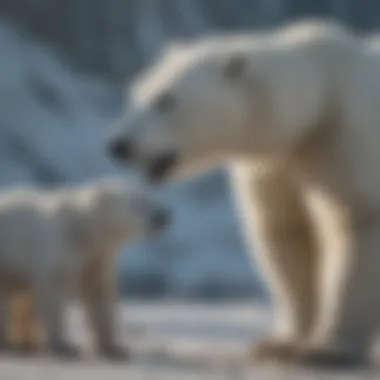

Legal protections are essential for the well-being of polar bears. Many countries have enacted laws that provide specific safeguards. In the United States, the Marine Mammal Protection Act prohibits hunting and the harassment of polar bears in U.S. waters. Similar legislation exists in Canada, where polar bears are protected under the Species at Risk Act. These laws limit human interference, which is vital for the bears during their breeding and hunting seasons.
Efforts also include international treaties such as the Agreement on the Conservation of Polar Bears. This agreement, established in 1973, unites several countries to collaborate in monitoring polar bear populations and managing their habitat. Legally sanctioned quotas define hunting limits to ensure that polar bear populations remain sustainable. This strategic legal framework plays a significant role in reducing human-related risks to polar bears.
- Important aspects of legal protections include:
- Restricting hunting.
- Guiding sustainable practices.
- Providing frameworks for research efforts.
Community Involvement
Community involvement is another piece of the conservation puzzle. Local communities are crucial stakeholders in the survival of polar bears. Engaging them promotes stewardship and awareness of the challenges facing these animals. Programs that educate residents about polar bears, their habitat, and the impact of climate change contribute to a more informed public.
Collaboration between researchers, local governments, and Indigenous peoples enhances conservation strategies. Indigenous communities often possess valuable traditional knowledge about polar bear behaviors and habitats. By integrating this knowledge with scientific research, conservation methods can become more effective. Furthermore, initiatives such as eco-tourism create economic incentives for locals to protect polar bears rather than exploit them.
Key elements of community involvement include:
- Educational programs in schools.
- Workshops on sustainable practices.
- Partnerships with wildlife organizations.
"The future of polar bears hinges on the commitment and actions of communities everywhere. Together, concerted efforts can result in meaningful change."
Future of Polar Bears in the Wild
Understanding the future of polar bears in the wild is crucial for grasping the intricate balance within the Arctic ecosystem. Polar bears are not just solitary creatures; they play an essential role in their habitat. By recognizing how climate change and human activities influence their survival, we can inform conservation efforts and elevate awareness about the challenges they face.
Adaptive Strategies
Polar bears possess several adaptive strategies that enable them to survive harsh conditions. These adaptations are critical as they must tackle changing environments due to climate fluctuation.
- Hunting Techniques: Polar bears typically rely on sea ice to hunt seals, which is their primary food source. They use stealth and patience, often waiting near breathing holes in the ice. As ice diminishes, they are forced to travel longer distances to find food.
- Physical Adaptations: These bears have thick layers of fat and dense fur. These features insulate them from cold and are vital for survival in freezing temperatures. While they are well adapted to their current environment, the rapid warming of the Arctic puts these strategies to the test.
- Behavioral Flexibility: The ability to adjust hunting patterns or migrate to different areas in search of food illustrates a polar bear's flexibility. However, with habitat loss occurring faster than they can adapt, their survival is increasingly threatened.
Predicted Trends in Predation
As we look to the future, trends in predation involving polar bears are changing. The interaction between different species also impacts their survival. Here are some key trends to consider:
- Increased Competition: With climate change, other carnivores may encroach on polar bear territories as they seek food. This competition can lead to increased stress for polar bears, who are already struggling to find sufficient food.
- Prey Availability Dynamics: As the seals they hunt also depend on sea ice, decreasing ice coverage results in fewer seals. This could lead to significant shifts in the polar bear food chain.
- Human Encroachment: As humans expand their activities into Arctic regions, interactions with polar bears may increase. Encounters with human settlements often lead to conflicts, further exacerbating the challenges polar bears must navigate.
"The challenges polar bears face will ultimately shape their future in the wild. Understanding these dynamics is key to informing effective conservation strategies."
Closure
The topic of polar bear predators is more than just a series of facts. It's an essential part of understanding the Arctic ecosystem and the survival of this iconic species. This article reveals the connections between polar bears, their natural enemies, and the changes occurring in their environment.
Summary of Findings
Throughout this article, we discovered several key points:
- Predators and Threats: While adult polar bears have few natural predators, they face threats from orcas and other factors that affect their habitat.
- Environmental Changes: Climate change is a significant issue impacting polar bear behavior and the availability of prey, creating a ripple effect in the food chain.
- Conservation Efforts: Various measures are in place to protect polar bear populations, emphasizing the role of legal protections and community involvement in their preservation.
These elements highlight the complexity of interactions within the Arctic environment. Understanding how these dynamics play out is crucial for appreciating why polar bears are at risk and what actions can help them.
Call to Action for Awareness
Awareness about polar bear predators is vital. Here are some ways to get involved:
- Educate Yourself: Read more about the Arctic ecosystem through resources like Britannica or Wikipedia.
- Support Conservation Programs: Look for local initiatives or global organizations that focus on polar bear protection. Websites and community forums, like those on Reddit, can be great for finding ways to make a difference.
- Share Knowledge: Talk about what you learn with family and friends. The more people know, the more they can contribute to the conservation of polar bears.
By spreading information and supporting conservation efforts, we can all play a role in ensuring that polar bears continue to thrive in the wild.
